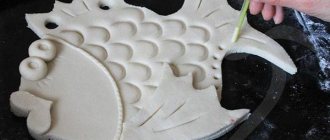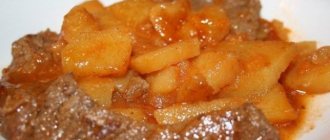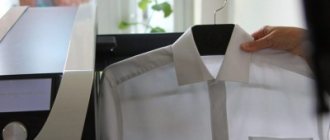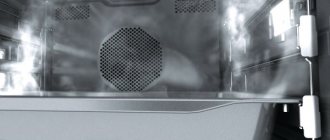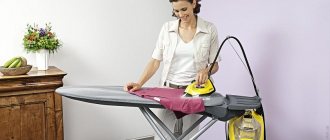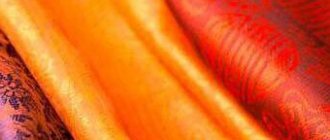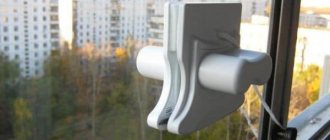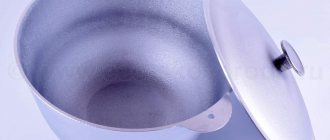At home, each of us constantly collects more clothes that need to be ironed after washing. Various household appliances will help you cope with this task. The most popular are the iron and steam generator. It will be difficult to make a choice, because ironing devices come in different types and perform different functions. In this review we will try to figure out what is better to choose – an iron or a steam generator.
Advantages of irons
One of the main advantages of irons is their low cost.
Technically, such a device consists of a heat-resistant housing, a heater, a substrate, and is sometimes supplemented with a simple steam generator. Therefore, the price for them starts at 1,500 rubles. But this is not their only advantage.
Power consumption
The iron consumes approximately 1.5 - 2 times less electricity than a steam generator. Considering today's electricity prices, this is very relevant. But you need to take into account that the heating element of even the simplest iron is designed for a power of 1 - 2 kW, that is, these devices cannot be called “economical”.
Easy care
The only thing that is required from the user of the equipment is to periodically clean the sole from carbon deposits. To do this, use a cleaning cloth or a special pencil, which cost less than 100 rubles.
In some irons that have a water container, it also sometimes needs to be washed with a citric acid solution or specialized descaling products.
Ease of use
No special skills are required to understand the functionality of a regular iron. All you have to do is plug it in, set the switch to the desired temperature setting, and you can immediately start ironing.
If the steamer functions are supported, pour water into the container and periodically spray the clothes or fabric with hot steam during the ironing process.
Takes up minimal space
There are even portable cordless iron models that you can take with you in your suitcase on a trip. To store such a device you will also need a minimum of free space.
Iron
Irons work by bringing the surface of the device into contact with the fabric. New models are divided into several main types:
- steam;
- with sprinkler;
- mini irons (travel);
- steam stations.
The devices quickly and effectively smooth materials by heating the ironing sole and applying pressure to the fabric. Both the speed and quality of ironing depend on the ironing surface.
For example, modern irons equipped with an aluminum surface have a number of conveniences: lightness, fast heating speed. An alternative to this material is titanium coating. It is more durable and glides smoothly across the fabric.
The irons are also portable and compact. Mini travel irons (with plenty of space and regular ones) fit comfortably into suitcases without taking up much space.
If you need to iron a large number of things, for example, at work or with a large family, steam stations are ideal. Thanks to the dual effect of steam to soften creases and ironing to straighten them, the iron can handle any amount of ironing with extra water and fast heating.
Disadvantages of irons
The key disadvantage of irons is the lack of additional functions. And steaming, even if provided in some models, is only conditional. And these are not all the shortcomings of these devices.
Not suitable for delicate fabrics
There is a wide range of fabrics that absolutely cannot be subjected to heat treatment. That is, there is a risk of damage to the material if the required temperature conditions are not observed.
Needs an ironing board
To iron things, you need a flat surface that is resistant to high temperatures. That is, you still need to allocate space for storing the ironing board. For small houses and one-room apartments this can be a real problem.
Not suitable for all clothes
If the clothes have small folds, cuffs, or complex seams, then it will not be possible to iron them properly. That is, the mobility of the iron leaves much to be desired.
The same applies to bulky outerwear or soft toys - it is impossible to iron them.
Heavy weight
Both the heater and the water container are all located in a single housing. Ironing for a long time really gets your hands tired. In steam generators, the water container comes separately; during operation you only have to hold a small handle.
Requires constant refilling of the water container
In irons, the water capacity is, on average, 30 - 40 milliliters. During the ironing process you will need to refill it several times .
And you also need to use filtered water. Otherwise, scale will form in the nozzles. If it is not removed in a timely manner, the iron will become unusable (or use without steaming).
What is better to choose: pros and cons
When choosing an ironing device, you need to rely on the functions that you need: if you need to iron a small amount of laundry, then an iron is enough. If the ironing process is constant and its volume is large, then it is better to buy a steam generator.
Irons
When purchasing an iron, pay attention to:
- Sole – it must be durable and withstand high temperature changes.
- Availability of additional features - you can buy a model with a built-in steam generator or turning steam.
- Handle – in order to comfortably use the equipment, the handle of the household appliance must be comfortable.
Advantages of the iron:
- Price – The price range of this device is very wide, so choosing an option will not be difficult.
- Mobility.
- Compactness.
Minuses:
- It takes a lot of time to smooth the fabric.
- There is a danger of burning the fabric.
- The quality of ironing is not always satisfactory.
Advantages of steam generators
Steam generators are adapted specifically for steaming. And this is a more delicate and high-quality processing of clothing. The steam cannot be heated above 90 - 100 degrees Celsius, so it will not damage the fabric.
Use without ironing board
To steam with a steam generator, you do not need an ironing board; clothes are placed vertically. And due to this, ironing is done much faster.
Steam boost
The pressure of the steam emitted by the steam generator is 2 - 3 times higher than that of irons. Therefore, it is suitable for processing dense fabrics. There is no need to steam the outside first and then turn the clothes inside out.
Fast heating
From the moment of switching on until the steam generator reaches operating mode, it will take only a minute. The iron will need 3 – 5 minutes for this.
Water tank volume
The capacity of the steam generator tank is from 2 liters. One refill is enough for 2 – 3 hours of active work. During this time, you can iron almost all the things from your home closet!
Removes unpleasant odor
Therefore, it is recommended to use it for ironing children's clothes. The steam generator also removes the smell of detergent or washing powder (there are those for whom such aromas cause an allergic reaction).
Additional functions
The strength of the steam boost, the temperature - all this can be finely adjusted.
Most steam generators have an integrated digital control unit with convenient display of information on a digital display.
Operational resource
Manufacturers of steam generators often provide an official warranty for equipment valid for 3 years. For irons this figure is only 6 – 12 months.
How does a steam generator work?
The design of these devices is very different from the traditional models found in almost every home. A steam station, unlike a conventional steam iron, uses an external steam generator (it is this that is used as the basis for producing steam.)
The ironing part itself resembles a traditional iron. Steam escapes through holes in the sole.
However, in this case it is generated on an external steam generator, from where it is transported via a special cable directly to the iron. Ironing fabrics with this device occurs mainly due to the release of a large amount of steam, which softens and smoothes the surface of the materials, and not at high temperatures, which are harmful to the fabric.
Thanks to this, steam stations work perfectly even with the most delicate and fluffy laundry.
When choosing a generator, the steam pressure level (indicated in bars) plays a big role. The higher it is, the better the steam output, and, accordingly, the ironing process.
The minimum for the steam generator is 5 bar. Just like a traditional iron, the steam station has a water reservoir.
However, the steam generator uses water faster, so the tank here needs to be larger. At the same time, steam stations are very prone to the formation of lime deposits, which, in turn, means the need for frequent cleaning of the tank or the use of demineralized water.
Therefore, the steam generator involves the use of special anti-scale rods against scale and limescale, which are inserted into the steam supply switch and purify the water.
Disadvantages of steam generators
The main disadvantage is the cost.
The average price of modern steam generators starts at 15 thousand rubles, therefore, when the budget is limited, most people prefer traditional irons.
Noise during operation
Steam generators also make noise during operation. Although slightly, the irons are completely silent.
Electricity consumption
Modern steam generators consume about the same amount of electricity as irons. More outdated models consume about 2.5 kW and require high-quality electrical wiring in the house.
Takes up more space
Both ironing and storing the steam generator require more space. But still less than for an iron and ironing board.
How to use and store?
Despite the fact that the models of steam generators differ from each other, the general principle of operation is approximately the same:
- First place the generator (station) on a stable surface.
- Remove the water tank and fill it with water until it does not exceed the maximum level, and then install it back.
- Unwind the cables and connect the device to the mains.
- Place the iron on the base of the steam generator and lock it until it clicks.
- Select a program or set the temperature.
- Wait until the device warms up (usually indicated by flashing LEDs).
- When the generator is ready, remove the iron and start ironing.
- If the “automatic” mode is set, then steam will be output automatically; if the iron does not have an automatic mode, then the steam output must be controlled manually by pressing the corresponding button.
- After ironing, turn off the device, wait until it cools down and drain the water from the tank.
As you can see, the process itself is simple. However, it requires good orientation in the programs that are available in the device, so before use you should definitely read the instruction manual.
The steam level is adjusted based on the thickness of the fabric being ironed. It is recommended to store both the steam generator and the steam iron in a separate box or on a shelf out of reach of children.
Which technique is preferable for certain tasks?
Although a steam generator has a greater range of functions and is superior to an iron in all respects, for some tasks its purchase will be unprofitable.
Upholstered furniture processing
An iron is not at all suitable for this task, as it can damage the skin due to the high heating temperature of the sole. And foam rubber is often used as a filler for upholstered furniture, which cannot withstand heating above 100 degrees (it will melt).
Bed linen treatment
For this task, both an iron and a steam generator are equally suitable. But the latter are much more comfortable to work with, since oversized sheets and duvet covers constantly have to be rearranged on the ironing board.
Ironing trousers, shirts
Using a steam generator is faster and more convenient. An iron is also suitable in most cases, but it cannot properly iron clothes with a large number of folds, cuffs or decorative accessories. Also for thick jeans, a steam generator is also the best choice.
Ironing winter outerwear
For this you can only use a steam generator. Especially when it comes to down jackets with artificial filling (and such jackets are the most common). Ironing is also not suitable for coats or fur coats.
Processing of soft toys
Iron is strictly contraindicated, since the toys are made from synthetic fabrics and filled with foam rubber. The steam generator allows for antiseptic treatment against carpet and bed mites. And due to the power of the steam boost, the steam penetrates to a depth of up to 1 centimeter. The same applies to pillows.
Ironing towels
A steam generator is also preferable. And only it can be used for ironing thick terry towels made from natural fabrics.
Features of universal steam generators
A steam generator is a device that is primarily intended for ironing things. It works well in areas that a regular iron cannot. Usually such problem areas are cuffs, folds, frills, and the situation worsens if it is also a delicate fabric.
According to the experience of many users, in a competition between a steam generator and an iron, the first one wins. However, if we compare the steam generator and the steamer with each other, the steamer is a more bulky and expensive unit. This is due to greater capabilities and expanded functionality. But if the user’s demands on the device are not so great, then a cheaper and more compact steam generator will fully justify itself.
A few more differences between modern steam-powered devices:
- Steam generation method. The steam generator operates on dry steam and under pressure, while the steamer does not need pressure and creates wet steam.
- Steam temperature. For a steam generator it is 140-160°C, and for a steamer it is about 100°C.
- Time to prepare to start work. The multifunctional steam generator will need 7-9 minutes, and the steamer can begin to be used in less than 1 minute after turning on.
- The steamer only works vertically, and in another position water begins to flow out of it. The steam generator does not have such problems, and it works equally well in both vertical and horizontal positions.
So, if among your home appliances you already have a washing vacuum cleaner that can easily clean stains from carpets and furniture, then there is no point in buying a steamer. It is not reasonable to use it only for ironing and pay such a lot of money.
Comparison of the functionality of irons and steam generators
Modern irons are only suitable for ironing; it is also possible to regulate the heating temperature (3 – 5 positions, without setting the exact value). The steaming function is only conditional; there is no protection against splashing drops.
Steam generators allow you to finely regulate the temperature. There are models where it is installed automatically, depending on the selected type of fabric. And such devices have several additional operating modes.
REFERENCE! There are also ironing stations. Technically, these are steam generators, but they also include a regular iron. All this is in a single stand housing, which also houses a water tank. This technique is mainly used in industrial laundries.
Vertical steaming
Vertical steaming allows you to iron your clothes as quickly as possible by simply hanging them on a hanger. There is no need to dry or cool it after this.
Continuous steaming
By default, steam generators are designed to automatically turn off the steam supply after 15 - 30 seconds. This reduces electricity consumption, prevents overheating of equipment and damage to fabric. Continuous steaming is useful when processing soft toys, winter outerwear, and furniture.
Protection against splashing water
Steam generators and steam stations are protected from splashing water due to the special design of the nozzle. Therefore, there is no risk of tissue damage or burns. Also, the ironing is of the highest quality, without “hidden” folds or light spots from hot water.
Steam boost
This is a function of short-term steam supply at maximum pressure. Allows you to smooth out the tightest wrinkles that cannot be removed with an iron or simple steaming. In steam generators, you can also set the steam boost power (on average, from 70 to 200 ml per minute).
Steamer
More recently, steamers have appeared in people's everyday life. At the moment they are classified by type:
- vertical;
- ironing systems;
- manual.
Steaming devices combine the functions of ironing and “softening” fabric. Moreover, steamers are ideal for working with complex fabrics: linen, pile, corduroy or even fur.
Removing iron shine from clothes using home remedies
The basic operating principle of the device is the release of water steam under strong pressure. This allows you not only to effectively remove wrinkles, but also to disinfect pieces of furniture covered with fabric, soft toys, curtains, without removing them, etc.
Also, for example, hand-held steamers can combine all these functions and fit in your hand. However, the volume of water in this type of housing is designed for 1-2 things. Therefore, a handheld steamer cannot be used for large amounts of work.
Device maintenance
Both the iron and the steam generator require regular maintenance (as recommended by the manufacturer) to keep the device in good condition and suitable for use.
Iron maintenance
Periodically it is necessary:
- Clean the soles. To do this, you need to turn on the iron and switch it to medium or maximum heat. And then treat the sole with a special cloth (acts as an abrasive element) or with a cleaning pencil (it reacts chemically with carbon deposits without damaging the metal base).
- Clean the steam system. In some iron models, this function is provided by the manufacturer itself. You only need to fill the tank with water, turn on maximum heat, and then press the “clean” button while holding the device over the sink. If such functionality is not provided, then for cleaning it is recommended to use a citric acid solution (1 teaspoon per 100 milliliters). Pour it into the tank, turn on the maximum heat, and then use the steam boost button to empty the container (holding the iron over the sink).
After using the iron, it must also be allowed to cool for 5 - 10 minutes and only after that can it be moved to its permanent storage location.
Maintenance is recommended after every 5th use.
Steam generator maintenance
To maintain steam generators, it is necessary to periodically:
- Clean the water level sensor. How to remove it is to be clarified in the technical instructions (the procedure varies somewhat depending on the model). Next, the sensor is visually inspected for contamination (limescale deposits) and damage to the insulation. Clean only with non-metallic brushes. Float-type sensors (common in steam generators produced before 2010) must be cleaned using reagents (you can use a citric acid solution).
- Clean the container from scale. Manufacturers recommend using a weak soap solution or special reagents for removing limestone deposits for these purposes. The same applies to the working nozzle, where the nozzles are located. An unconcentrated solution of citric acid can also be used. But you shouldn’t add a product to the water to reduce its hardness - this technique is not compatible with it.
In summary, if there are no budget restrictions, then it is definitely recommended to buy a steam generator. It has wider functionality, irons clothes and fabrics more delicately, and can be used without an ironing board. Its average service life is 5 years with regular use (2 – 3 times a week).
Iron or steam generator: which is better?
In one Roskachestvo rating you can find irons and steam generators: we specifically test these devices using the same program so that they can be objectively compared. The average scores for irons and steam generators are approximately the same: 3.33 and 3.40, respectively, so it can hardly be said that one of these devices is better than the other. It all depends on the specific model. Yes, there is only one steam generator in the top 5 of the Roskachestvo rating, and only two in the top 10. But this, rather, suggests that in general there are more irons on the market, they have a wide range in quality and capabilities. Both devices have the same average scores for convenience and resource intensity (reliability), so we can dispel two myths at once: that irons are more convenient and that they are more reliable.
Irons and steam generators perform similar tasks, but choosing one over the other will depend entirely on your needs and priorities. So, let’s decide in which case you need to buy an iron, and in which case – a steam generator.
We choose an iron if:
- you iron little and infrequently;
- you need the formation of folds and “arrows” on clothes;
- you need a simple device that you don’t need to understand;
- you need a device that doesn't take up much space.
We choose a steam generator if:
- you need not only classic ironing of clothes, but all the advanced functionality;
- Do you want to use vertical steaming?
- you plan to iron a lot and often;
- among your clothes there are many items with embroidery and lace.
Other options
Depending on the model, many irons and steam generators have a number of useful additional features. It is worth paying attention to them, because despite the fact that they are not decisive when choosing the optimal model, they can significantly affect the comfort of using the device.
The additional features work pretty much the same whether you choose a steam iron or a steam generator.
To add. functions may include: dry ironing, additional wetting of the fabric with water, several levels of steam volume control, continuous steam generation at maximum power (which makes it possible to smooth out tough folds more efficiently), etc. Some models also feature automatic ironing temperature selection, eliminating the need for manual adjustments.
Automatic shutdown
Among the useful features, in many modern models you will find an automatic shutdown system, which will protect your clothes from burning and help save energy if you accidentally left the iron on. For example, the safety system in PHILIPS Azur Elite GC5039 steam irons automatically turns off the iron after 8 minutes without moving in a vertical position and after 2 minutes in a horizontal position.
For steam systems from the same manufacturer, a similar function is automatically activated after 10 minutes of inactivity. This way you won't have to worry about accidentally leaving your iron on.
Antiscale
Modern steam generators are equipped with a convenient system for removing scale and lime deposits, using special filters that prevent limescale from settling inside the device. Thanks to this system, you can safely use water directly from the tap in your iron.
Depending on the model, the anti-scale system can be removable or permanent.
Auto temperature adjustment
Many irons and steam systems have automatic temperature control. Moreover, this function can be implemented differently in different models.
For example, the innovative iCare technology used in Braun TexStyle steam irons and Braun CareStyle steam generators eliminates the need to manually adjust the temperature, as the device automatically sets the optimal temperature for ironing all types of fabrics. This is a very convenient and safe solution, especially if you have a whole mountain of things, both hard and delicate.
If you are not satisfied with using a universal temperature mode for all types of fabric, then Braun also has steam stations with a TURBO mode, in which the iron temperature rises to 190°C and allows you to iron even the thickest fabrics.
Drop limiter
One problem that many iron owners face is that water vapor often condenses directly onto clothing, leaving nasty water marks. The drip stop is a special feature that prevents water from flowing out of the soleplate of the iron and protects the fabric from splashes, for example, when ironing at low temperatures.
Thanks to this function, water will not drain from the iron, even if it is unplugged and in a horizontal position. For example, DeLonghi irons and steam generators are equipped with advanced Anti Drip technology, which stops dispensing water until the device is completely heated.
Some more useful features
The above functions are not all that modern ironing systems can offer. Let's look at a few more useful features that will make the ironing process more comfortable and enjoyable:
- Possibility of using tap water. Both classic irons and steam stations are susceptible to limescale deposits. Irons with this feature have a special water filtration system that allows you to use tap water without worry.
- Vertical ironing. Some delicate items are best ironed in a vertical position - for example, on a hanger. So make sure your model supports this feature.
- The self-cleaning function will also clean the inside of the iron from limescale and other contaminants. It prevents the formation of deposits and ensures quick and intuitive cleaning of the device.
- Spray. While ironing, you can press a button to spray a little water onto the fabric. This helps smooth out wrinkles better.
- Temperature indicator light. Signals when your iron or steam generator has reached the required temperature and is ready for use.
- Castle at the steam station. Allows you to securely fix the iron on the steam station stand. This makes it easier to carry the device and prevents the iron from falling while being carried.
What is a steam generator?
The steam generator consists of a boiler, a steaming nozzle and a hose for supplying steam. Water boils in the boiler, very hot steam is formed, which, when you press the start button, flows through the hose into the steaming nozzle and comes out through the holes under high pressure. The steam temperature reaches 150-160 °C. Such superheated steam quickly and deeply penetrates the fabric, smoothing out deep folds and destroying mold, germs, and viruses. The steam generator easily copes even with dense or folded matter in several layers.
Characteristics of a steam generator with a boiler
Power
Depending on the model, this figure can range from 1300 W to 2600 W. The higher the power, the faster the ironing process will be completed. High power reduces the time it takes to heat up. But there is no need to talk about energy savings here. When choosing a steam generator for your home, it is better to opt for models that have a power of at least 2000 W. More economical stations take longer to heat up and hold the temperature worse.
Water tank (boiler)
How comfortable it will be to work with a steam generator depends on the volume of water that can be poured into it at one time. If the equipment will be used rarely or for ironing single items, then you can opt for a device with a small volume of water boiler. But for most users, ironing is a regular task. If you need to iron for several family members at once, then it is better to choose a steam generator, the water tank in which has a volume of more than 1 liter and a removable design with the possibility of topping up during operation. This is exactly the tank in LAURASTAR models. When it comes to choosing a professional device, for example, for sewing production or an atelier, you will need equipment with a large tank of up to 2.5 liters. External water tanks are made of transparent plastic. This allows you to control the liquid level and add water to the tank on time. In rare cases, you can find models in which the tank is made of opaque material. In this case, it is equipped with a water level indicator.
Steam supply
During the ironing process, the steam station supplies steam continuously. However, devices have different steam supply rates and pressure levels, measured in bars. Some models produce the stated maximum steam pressure values only at the moment of steam burst, when the device briefly increases the steam flow. LAURASTAR products are characterized by constant pressure with an optimal value of 3.5 bar. This is more than enough to easily smooth out complex wrinkles and steam clothes that are folded in several layers. Instead of a steam boost, pulse technology is used: steam is supplied in short intermittent pulses and penetrates deeper into the tissue. Steam generators have the function of a targeted steam burst, when at the right moment a powerful, directed jet of steam is released onto the fabric. The steam supply speed can vary in the range of 100-500 g/min. If this indicator is high, it will be easier to iron heavy, dense fabrics (for example, blankets, coats, thick curtains, etc.).
Outsole material
The quality of the sole affects:
- heating and cooling time;
- service life of equipment;
- ironing quality;
- tissue preservation.
There are a number of basic materials that steam system soles are made from.
Let's look at their main types: Aluminum soles are most often used by manufacturers of all steam generators: from inexpensive to premium brands. The main disadvantage of aluminum is its softness. Because of this, the sole is susceptible to scratches. It can be damaged by a lock or button. But the obvious advantage of such a sole is that it heats up quickly and cools down just as quickly. This means that when switching temperatures you will not have to wait long to continue the ironing process. Another advantage of irons with this coating is the low weight of the metal. The steam generator will be lightweight, you won’t have to spend a lot of effort on ironing, and your hands won’t get tired. To care for delicate fabrics, LAURASTAR comes with a special Teflon soleplate along with the steam generator.
Stainless steel is a material resistant to mechanical damage. Its main characteristics: reliability, wear resistance, durability. However, practical material affects the weight of the steam generator. Such devices weigh more than devices with an aluminum or ceramic sole. The smooth coating ensures good glide over the fabric. Manufacturers sometimes coat the steel soleplate with an additional layer of ceramic or Teflon, which adds non-stick properties to the soleplate. In this case, the device must be handled more carefully, since the coating is easier to damage. As for heating the system, you won’t have to wait long for the device to be ready for operation. But the aluminum sole will still heat up faster than stainless steel.
Ceramics and metal ceramics. This material is used in the manufacture of the soles of steam generators of medium and premium price categories. The high cost is due to the fact that the ceramic base has a number of useful properties:
- easy to clean from dirt;
- non-stick ceramics, does not leave black spots;
- is a durable material and more resistant to damage;
- even thin fabrics under the ceramic sole do not wrinkle, which improves the quality of ironing;
- high sliding ability;
- many models with this sole material are equipped with a self-cleaning function, as a result the iron does not leave marks or streaks on the fabric;
- characterized by relatively fast heating and slow cooling without the risk of damaging the fabric when switching modes.
Titanium is a rare material that is used for the soleplate of the steam system. This is due to its only, but very significant drawback - the price. Steam generators with titanium soles are more expensive than all analogs whose soles are made of alternative materials. This coating is used for the manufacture of premium devices. Among its main characteristics:
- ease of sliding on fabric;
- comfort and reliability in use;
- resistance to damage: not afraid of strong impacts, including from falling, exposure to chemical elements or other metals.
Anti-scale protection
An important characteristic when choosing a steam generator is its protection against scale. This function is not available in all models. Well-known and reliable brands such as LAURASTAR equip devices with a similar system. LAURASTAR steam generators are equipped with special water softening cartridges that protect against scale formation. In the absence of such a function, the owner of the steam system will have to monitor what kind of water is poured into the device’s tank. Even using distilled or filtered water does not guarantee a complete absence of plaque. If scale forms, it must be removed from the parts and walls of the device tank. If the steam generator has an anti-scale function, it will signal the need for cleaning.
Operating mode
A mandatory feature that you need to pay attention to when choosing a steam generator is the operating mode for which it is designed. There are three types of steam systems:
- steam generator without steam supply adjustment;
- equipment equipped with a manual adjustment system;
- device with an automatic adjustment system. In this case, he himself chooses which mode to set, depending on the type of fabric.
Advantages of steam generators
The steam generator has many strengths:
- quickly smooths out even heavily wrinkled fabric;
- cope with dense or folded matter in several layers;
- allows you to set the steam supply mode: constant supply or steam boost - flexible settings are useful for different types of matter;
- A spacious water tank allows you to iron longer without interruption;
- disinfects well due to the properties of dry superheated steam;
- There are steam generators with vertical steaming function;
- Some models are suitable for dry ironing: choose a steam generator with the appropriate function.
Popular models
It is difficult to choose the best iron with a steam generator; comfort and ease of use are individual parameters. Reviews of different manufacturers allow us to make a rating of the most popular brands.
- Philips. This is the leader in sales of irons with a steam generator. The most popular models are 9620 and 8650/80. The devices are lightweight, easy to use, and self-clean when scale occurs. The sole of both options is made of steel with metal-ceramic and titanium coating. The boiler capacity is 1.8 liters, pressure 6.5 bar, and has an auto shut-off function.
- Tefal. The popular models in the manufacturer’s assortment are GV 5245, GV 7760, GV 8975. The sole coating is cermet; during use, you can add water to the tank; there are a lot of additional functions. A minor drawback is its impressive weight: this iron weighs 5.5 kg.
- Braun. Models IS 5043 WH, IS 5044 BK. Boiler volume – 1.5 liters, steam pressure – 6 bar, iron sole – aluminum. The devices have useful additional functions.
- Bosch. The iron with a laundry steam generator of this well-known brand has a 1.3 liter tank, a 2 m long steam pipe, a cermet soleplate, and a maximum pressure of 5.5 Bar. The “stop-drip” function prevents condensation from forming when cooling.
- Kercher. Model 1801 is lightweight, small in size and durable. The steam tube is 2.5 meters long, the tank volume is 1 liter, the power is 2000 Watt.
Which steam iron is best to choose depends on your needs.
For those who are always in a hurry, it is important to pay attention to the time it takes for the device to heat up to operating condition. For those who use the device in the morning, when everyone is sleeping, a reduced noise level will be important. A device for an atelier should be more powerful than one for domestic use. And if you are into sewing, be sure to pay attention to the number of attachments for different types of fabric. back to all articles
Estimated cost
The financial issue is important for most users:
- modern irons cost on average from 1,500 to 5,000 rubles;
- the cost of a steam generator is from 7,000 to 20,000 rubles;
- clothes steamers cost from 6,000 to 16,000 rubles.
Sources
- https://setafi.com/bytovaya-tehnika/parogenerator/chem-otlichaetsya-parogenerator-ot-utyuga/
- https://legkovmeste.ru/poleznye-sovety/utyug-ili-otparivatel-chto-luchshe.html
- https://its-city.ru/dlya-uborki/chem-otlichaetsya-utyug-ot-parogeneratora.html
- https://vplate.ru/utyug/ili-parogenerator/
- https://setafi.com/bytovaya-tehnika/utyug/ili-parogenerator/
[collapse]
How does a steam generator differ from an iron with a steam function?
The iron is more compact and (as a rule) cheaper than a steam generator; it heats up in a matter of seconds, but the latter is much faster and can handle a large volume of laundry better. The main difference is that the steam in the steam generator is supplied under higher pressure and at a higher temperature. The result is a deeper impact. Steam generators are used in studios and dry cleaners, but they are also useful at home. It can steam bed linen folded several times in a couple of minutes.
Conclusions TheDifference.ru
- Ironing occurs due to the contact of the fabric with the heated soleplate of the device. The steam generator provides a contactless ironing process.
- The design of the iron includes a body, a base and an electric heating element. In addition to these structural fragments, the steam generator contains a water tank and a platform for the iron.
- The iron is ironed mainly in a horizontal position. The steam generator can be used for vertical fabric surfaces or surfaces located at an angle.
- The speed of ironing and its final result when using a steam generator are higher than when using a conventional iron.


